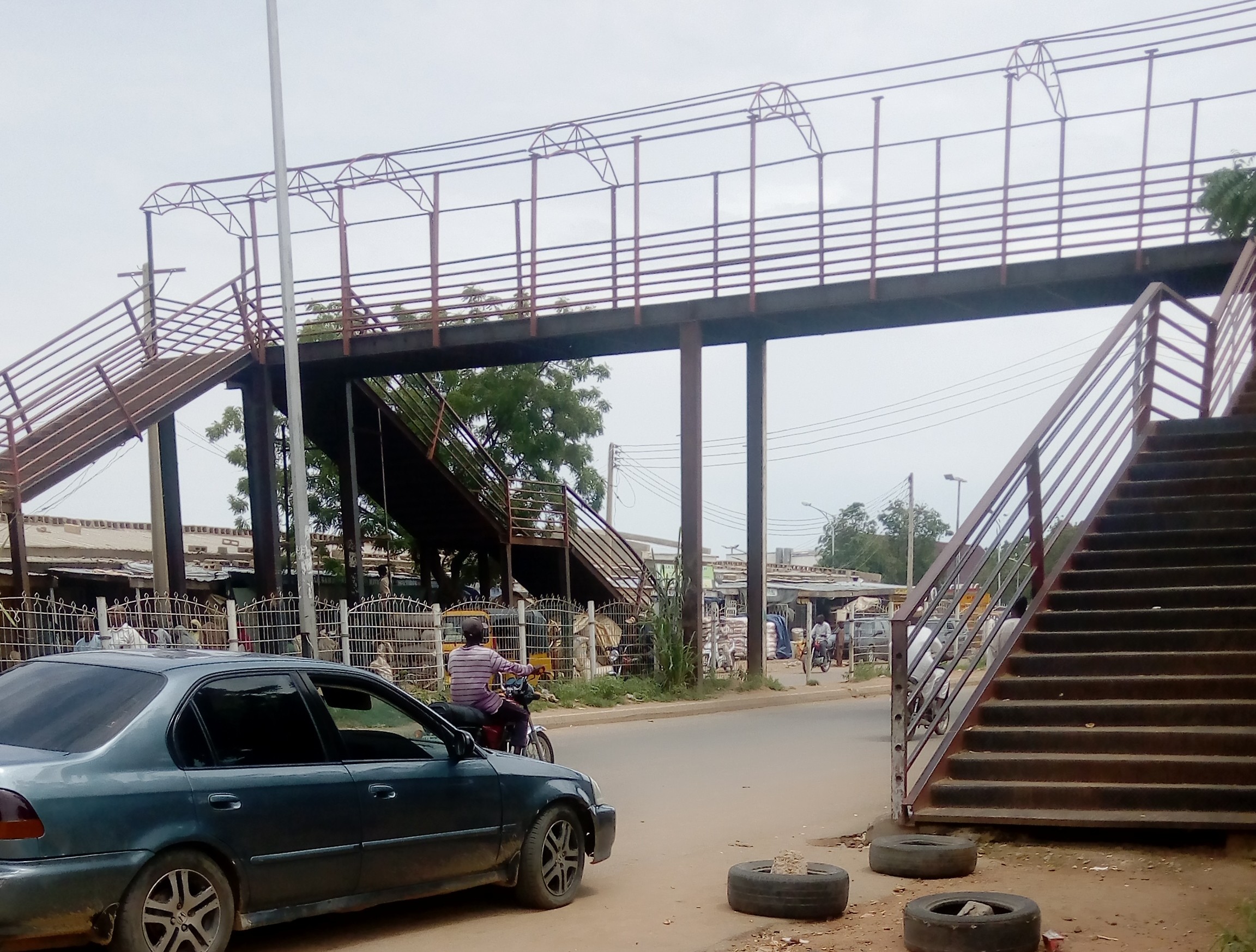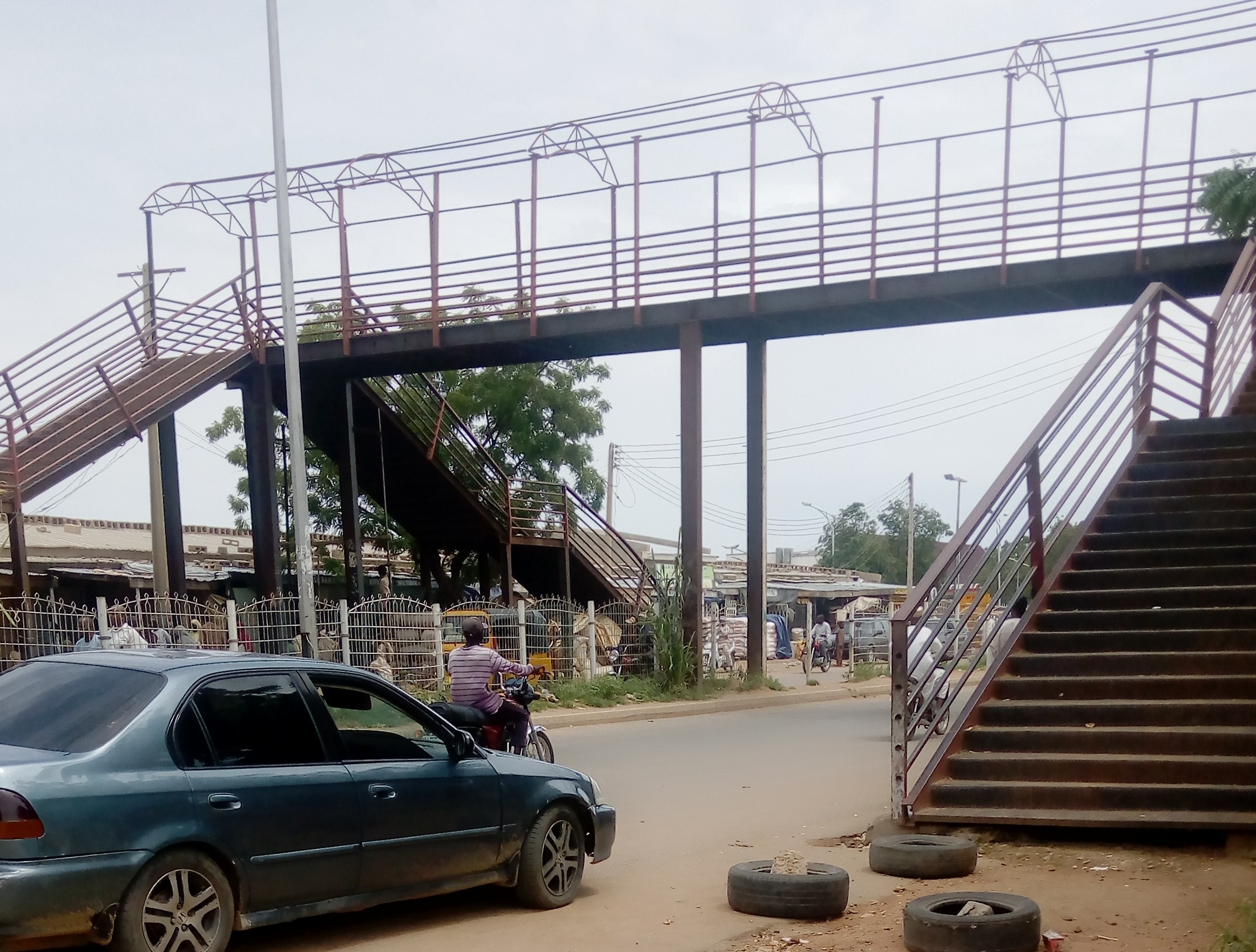CAR CULTURE
ROAD SAFETY
WALKING
Pedestrian bridges do not encourage walkable, livable communities, nor do they improve road safety for drivers or cyclists. Separating people from the street reinforces the prioritization of personal motor vehicles, while encouraging speeding, driver negligence, and traffic fatalities.
What are Pedestrian Bridges?
Pedestrian bridges are structures built over roads that require people to take longer, often inaccessible routes up and over many lanes of car traffic, without impeding the speed or movement of vehicular traffic. Proponents of these structures argue that these bridges are made for the safety of pedestrians, by moving pedestrians out of the way of speeding cars. In reality, by displacing people, pedestrian bridges simply reinforce the dominion of vehicles over people on the streets. Pedestrian bridges discourage walking and cycling and worsen road safety for drivers, pedestrians, and cyclists. Separating people from the street reinforces the prioritization of personal motor vehicles, while encouraging speeding, driver negligence, and traffic fatalities.
This pedestrian bridge exemplifies some of the major problems with pedestrian bridges: it includes a steep staircase with cars passing quickly beneath it.
Prioritizing cars, not people
Elderly woman struggling to climb steep pedestrian bridge
This woman in kastina is struggling to pass this pedestrian bridge, clearly not designed for people like her to pass easily.
Due to the hostile design of these bridges, pedestrians often forego using them and instead cross the roads underneath them. Pedestrians make decisions based on their environment: if their behavior is risky, it is often the result of inconvenient or inadequate infrastructure rather than poor decision-making. The added distance presented by pedestrian bridges not only creates a physical barrier for those unable to climb stairs or steep ramps, but it adds extra time and effort that pedestrians will try to avoid by simply crossing at-grade. For example, a study by ITDP kastina observed two locations close to Central market and found that 85-95% of pedestrians continue to cross at-grade even when pedestrian bridges are available. Furthermore, by keeping people farther away from cars, those motorists are given permission to drive faster and more recklessly. High vehicle speeds can be fatal for pedestrians. Even a speed increase from 50 kph to 60 kph, decreases the pedestrian survival rate from 50% to 10%. Pedestrian bridges are not associated with increased safety for pedestrians. For instance, in kano city, the boroughs (delegaciones) with the most pedestrian bridges have the highest rates of traffic crashes involving pedestrians and hit-and-runs, 27% of which occur within 300 meters of a pedestrian bridge. In Lagos, 43% of crashes involving a pedestrian happen within 500 meters of a pedestrian bridge. Statistically, pedestrian bridges are demonstrably not safe for pedestrians. Because the bridges give cars a sense of exclusive access to the road, drivers are less likely to be aware of, or look for pedestrians.
One of the primary problems with pedestrian bridges is that they are not designed in a manner that prioritizes ease of crossing for people. Pedestrian bridges are, on average, much longer than at-grade crosswalks. Compared to an average street crossing of 11 meters, the typical pedestrian bridge spans 103 meters due to ramps or stairways needed to elevate bridges above street level. These bridges are typically built with steep stairs or steep sloped ramps which are particularly challenging for people with disabilities, children, the elderly, and anyone carrying goods. Forcing people to climb high stairs discourages passage and when these areas are poorly lit, as is often the case, women in particular feel even more unsafe and vulnerable. These structures, are designed in a manner that is inconvenient for pedestrians, dangling them above speeding cars, and reinforces a mentality that drivers can drive as quickly as they would like. Additionally, when traffic incidents involving pedestrian bridges occur near or beneath pedestrian bridges, the drivers are often absolved of responsibility as the bridges send the message that pedestrians shouldn’t be on the street, is reinforced.
People walk beneath pedestrian bridge
A typical scene: people in kastina state, kastina pass underneath a rickety and steep pedestrian bridge, essentially negating the supposed benefits of the “pedestrian” infrastructure.
Improve existing intersections and add more mid-block crossings to make crossing streets safer and more comfortable for pedestrians.
A Better Option
To make streets passable and safe for people, cities should put pedestrians first by improving existing crosswalks and intersections and not building difficult-to-pass bridges. Crossings must be convenient, safe, and direct for pedestrians to actually use and benefit from their protection. City streets should have frequent crossings for pedestrians that are clearly marked, timed for a diversity of users, and at the same level as adjoining footpaths or sidewalks. Improvements to existing intersections and installing new infrastructure like speed bumps or mid-cross refuge islands is often less costly than building and maintaining off-street pedestrian infrastructure. For example, in Mexico City, a simple pedestrian bridge costs about 1.5 million pesos ($80,000 USD) while the cost of traffic control mechanisms relating to crosswalks averages less than 800,000 pesos ($42,000 USD). In Kenya, recent large-scale pedestrian bridges over arterial streets have cost nearly $2 million USD. On average, maintenance over time for pedestrian bridges is more than double that of at-grade crossings.
Investing in on-street pedestrian infrastructure ensures significant short and long term returns. Cities in the Vision Zero network such as New York and Boston, as well as cities leading in pedestrian-first design such as Guangzhou and Mexico City, are constructing relatively low-cost pedestrian infrastructure. Curb extensions, protected intersections, automatic walk signals, and pedestrian head starts are being implemented in place of pedestrian bridges as a means of reducing traffic fatalities. These cities have seen the benefits of building for people first – increased foot traffic drives economies and improves public safety. In Auckland, New Zealand, pedestrian delays at just two city center crossings were found to have a combined annual economic cost of nearly $3 million. In Zhaitang Town, China, a targeted pilot of traffic-calming infrastructure including pedestrian refuge islands, raised intersections, and speed humps resulted in increased use of crossings and decreased road traffic injuries.
To prioritize people, streets need to be designed with pedestrians first, and cars next. Moving people out of the way of cars sends one message: these streets exist not for people but for cars.

